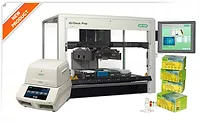Amick Farms Adopts Cutting-Edge Pathogen Detection Technology

Rapid DNA-based methods are increasingly being used by food producers to detect unwanted bacteria in their products. Amick Farms, a poultry processor based in Batesburg, South Carolina, recently adopted this cutting-edge technology, upgrading their pathogen detection method to the WarnexTM Rapid Pathogen Detection System.
Amick Farms is a fully integrated processor of chicken products, which are sold across the United States and worldwide. Family-owned and operated since 1949, Amick Farms employs more than 1,200 associates and produces more than 4 million pounds of fresh poultry each week in its state-of-the-art facilities.
“Our core values include our dedication to providing products of the highest quality and safety for our customers,“ said Frank Wier, director of quality assurance at Amick Farms. “With our newly constructed laboratory and this state-of-the-art testing technology, we are confident that we meet and exceed USDA inspection requirements and that our food safety program is at the forefront of our industry.”
Amick Farms made the decision to move from another pathogen detection method to the Warnex System following an extensive evaluation over several months. “We found many advantages to switching to the Warnex system from the immunoassay-based method we were using previously,” said Wier. “First, we can obtain results within 24 hours instead of 36 hours, and moreover, they are more accurate. Second, the Warnex platform is more versatile and offers a wider range of pathogen tests, including a pipeline of tests to come. Finally, we wanted to move to the Warnex System since PCR technology has been adopted by government regulators and will become the gold standard for the entire industry.”
The Warnex Rapid Pathogen Detection System assesses the presence of pathogens by rapidly and specifically identifying the DNA signature of a specific target organism. The DNA signature of each organism is unique, so DNA-based identification is both highly specific and accurate. The Warnex System can be used to detect Salmonella, Listeria monocytogenes, Listeria species and Campylobacter directly in foods or in the processing plant environment.
Simpler, Faster, More Accurate
In addition to being the most accurate pathogen detection method, the procedure for the Warnex tests is much simpler and faster than traditional detection methods. A non-specialized lab technician can process samples and receive results within 3 to 48 hours, a significant improvement over traditional microbiology tests that require from 5 to 7 days.
The simple three-step detection process starts with the enrichment of the food sample, followed by DNA extraction, and is completed with DNA amplification and analysis. In the third step, the Warnex System uses real-time polymerase chain reaction (PCR) technology. PCR is a technique used for replicating a specific target sequence of DNA that, in this case, identifies a species or strain of bacteria. Once the DNA is extracted from a sample, molecular markers, also known as primers, are added to identify or “mark” the DNA sequence of interest for the subsequent amplifying action of an enzyme called polymerase. A single copy of the target DNA can be amplified to obtain billions of copies. For the food testing market, this means that as little as one single cell of Salmonella can be amplified for easy detection.
In addition to using these molecular markers, or primers, Warnex’s real-time PCR system also uses molecular beacons to detect and identify a unique DNA signature, thus providing two levels of specificity. This allows for the highest level of accuracy to confirm the identity of the pathogen being tested. Molecular beacons fluoresce once they recognize the targeted bacterial DNA sequence. The amount of fluorescence produced is proportional to the amount of DNA amplified and recognized by the beacon. This particular feature of real-time PCR provides Warnex’s customers the opportunity to obtain quantitative as well as qualitative results.
In addition to the simple procedure, what makes the whole system so user-friendly is that the system’s software analyzes and interprets the results, providing a straightforward answer of “positive” or “negative”. Unlike traditional pathogen identification methods that require interpretation, the Warnex System removes this source of human error. In addition, the system allows for the immediate reporting of results throughout the organization and, most importantly, to key decision makers.
“The Warnex Rapid Pathogen Detection System uses innovative and state-of-the-art technology to combine speed and ease of use, without compromising accuracy and reliability,” said Mark Busgang, President & CEO of Warnex. “Our technology has the potential to completely reshape the food diagnostics industry.”
What do faster, more accurate results mean to food producers like Amick Farms? Faster decisions based on reliable test results. Faster inventory turnover leading to financials gains and a competitive edge. A reduced false positive rate offers less chance of a costly recall and increased brand protection. It is these benefits that drive food companies to use the best pathogen detection technology available.
warnex.ca
Looking for quick answers on food safety topics?
Try Ask FSM, our new smart AI search tool.
Ask FSM →








